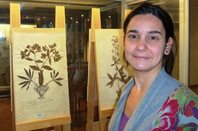
Sylvia Mota de Oliveira[1]
The three countries forming the Guianas - Guyana, Suriname and French Guiana - have more than 80% of their political territories covered by pristine Amazon forest. The Flora of the Guianas book series provides taxonomic treatments and associated data on plant species occurring in the region. At present, the published fascicles cover around 25% of the total of species recorded in the Guianas, with a total of 2294 species treated only in series A: Phanerogams and around 1000 species in other series, covering Ferns and Fern allies, Bryophytes and Fungi. Beyond taxonomy, the Flora is a rich and well curated source of primary biodiversity data. To efficiently use this source and build it further, we want to move towards an online platform, where:
- Data extracted from other literature sources (Flora of Suriname, for instance) can be incorporated in a database and used as a basis for upcoming taxa treatments, increasing the rate of species descriptions;
- Data gathered in the Flora fascicles can be disclosed and made available in a structured and searchable manner, openly accessible to end-users;
- Interaction between Flora contributors, specialists and citizen scientists is promoted;
- Links between elements of the Flora and external content, such as collection and molecular databases, can be easily enabled;
- Updates of the taxonomic data can guarantee the quality and usability of the Flora in several other research fields.
To achieve these goals, the transference of the data from the printed copies of the Flora of the Guianas to such an online platform requires mark-up of text. The new workflow is being tested in a Pilot study within the pro-iBiosphere project, which will hopefully support the planning of a longer-term strategy for the complete Flora.
The first results of the pilot were presented and discussed during the pro-iBiosphere workshop on "How to promote and foster the development & adoption of common mark-up standards & interoperability between schemas" that took place on the 8th of October 2013, in Berlin. The workshop was very instructive and useful for the future strategy of the Flora of the Guianas. In this workshop, participants shared their experiences, and discussed together the most important issues/challenges that they have encountered while working on text mark-up. The heterogeneity of the group added to the discussion because participants were confronted with different levels of: 1) experience with mark-up tools; 2) data granularity; 3) consistency in the format of the content to be marked-up. Relevant topics discussed included the scaling of the mark-up activities using different tools, the costs and possible incentives for such an activity, the desired level of granularity of the mark-up, and best practices to be adopted by taxonomists and bioinformaticians.
[1] Editor of Flora of the. Guianas, Naturalis Biodiversity Center, the Netherlands. Contact: [email protected]





 pro-iBiosphere wiki platform
pro-iBiosphere wiki platform
 RSS news
RSS news Print this article
Print this article
